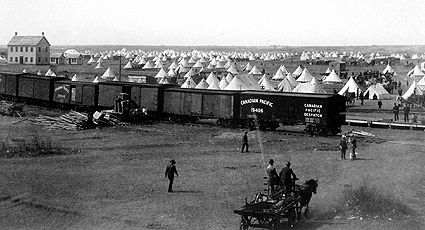
Athabasca Landing
Athabasca Landing, at the site of the present town of Athabasca, Alberta, was from 1876 until 1913 an important trading centre linking the Prairies with the far Northwest. Known locally as "the gateway to the North," the Landing was also used by the Anglican Church as headquarters for its missionary activity in the Northwest, and from 1895 to 1916 served as the seat of the extensive diocesan see of Athabasca.
Its commercial development began in 1876 when the Hudson's Bay Company, seeking a better fur-trade route to the Peace River region, completed construction of the Athabasca Landing Trail from Edmonton. The small HBC post at Athabasca Landing, established 1877, expanded during the 1880s when the company made it the headquarters of a new network of steamboat transportation on the North Saskatchewan, Athabasca, Slave and Mackenzie rivers, and the home-port of the SS Athabasca (launched 1888).
During 1897-98 a tent-city at the Landing was the effective starting-out point for adventurers following the all-Canadian water route to the Yukon goldfields, and both the Klondike Gold Rush and a lengthy visit by the Indian Treaty and Scrip Commission in 1899 stimulated the growth of a village around the HBC post. In the mid-1900s the HBC monopoly of the local fur and carrying trade was challenged successfully by rival businesses while the number of steamboats built, docked and serviced at the Landing increased dramatically.
The expanding river traffic, the arrival of thousands of homesteaders, a speculative real-estate boom and railway fever brought rapid economic and demographic growth from 1909 to 1913. In 1911 Athabasca Landing was incorporated as a town, and by August 1913, when its name was changed to Athabasca, the new municipality had a population approaching 2000. However, by 1919 railways had bypassed Athabasca and destroyed its raison d'être as an inland port.

 Share on Facebook
Share on Facebook Share on X
Share on X Share by Email
Share by Email Share on Google Classroom
Share on Google Classroom


